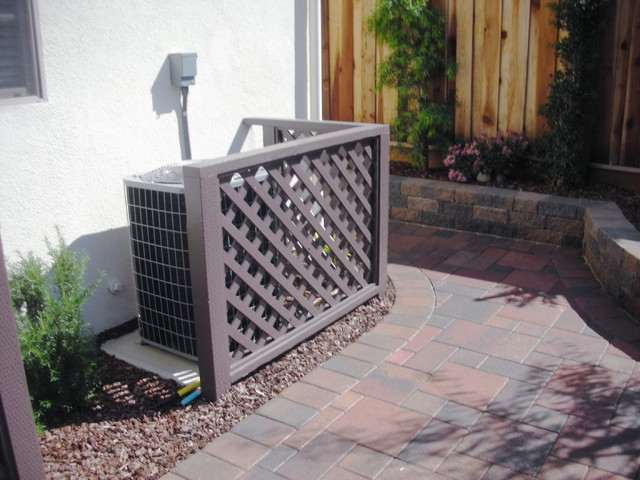
Landscaping Around Outdoor Units
When it comes to landscaping around outdoor units, it’s important to find a balance between functionality and aesthetics. Whether you have an air conditioning unit, a generator, or any other outdoor equipment, there are several things to consider in order to create an attractive and efficient outdoor space.
1. Concealment with plants
One of the best ways to mask an outdoor unit is by strategically placing plants around it. Consider using tall, dense shrubs or trees to create a natural barrier that will both hide the unit and provide extra shade.
2. Use decorative fencing
An attractive option is to use decorative fencing to enclose the outdoor unit. Choose a style that complements your existing landscape and consider adding a gate for easier access when needed.
3. Incorporate a small garden
Turn the area around the outdoor unit into a beautiful garden. Choose colorful flowers, vibrant plants, and decorative mulch to create an eye-catching feature that draws attention away from the equipment.
4. Install a trellis
If you want to add a touch of elegance to the area, install a trellis and train climbing plants to grow on it. This will not only provide additional privacy but also create a visually appealing focal point.
5. Build a decorative screen
Consider constructing a decorative screen that will both conceal the outdoor unit and serve as an attractive design element. Use materials such as lattice, woven wood, or metal panels to create an interesting pattern.
Remember, when landscaping around outdoor units, it’s important to keep in mind the accessibility and maintenance needs of the equipment. Make sure to leave enough space for technicians to perform any necessary repairs or maintenance tasks.
By following these tips and ideas, you can transform your outdoor space into a beautiful and functional area while effectively hiding those necessary but unsightly outdoor units.
Enhancing Curb Appeal
When it comes to outdoor units, landscaping plays a crucial role in enhancing curb appeal. Whether you’re looking to improve the appearance of your home or attract potential buyers, a well-designed landscape can make all the difference. Here are some tips and ideas to help you create a visually appealing outdoor space:
- Choose the right plants: Select plants that are suitable for your climate and the area around the outdoor units. Opt for plants that are low-maintenance and can withstand the heat and direct sunlight.
- Add color and texture: Incorporate plants with vibrant flowers, foliage, and interesting textures to create visual interest around the outdoor units. Consider using a mix of perennials, annuals, and shrubs to ensure year-round color.
- Create a focal point: Use a focal point, such as a decorative statue, a birdbath, or a decorative pot, to draw attention away from the units. This can help divert the focus from the functional aspects of the outdoor units and add a decorative touch instead.
- Use containers: If you have limited space or prefer a more flexible approach, use containers to showcase plants around the outdoor units. This allows you to easily move the containers and change the arrangement as needed.
- Incorporate natural elements: Consider adding natural elements such as rocks, stones, or a small water feature to create a harmonious and relaxing atmosphere. These elements can help soften the look of the outdoor units and create a cohesive design.
- Maintain cleanliness: Regularly clean and maintain the area around the outdoor units to ensure they look their best. Remove any debris, trim overgrown plants, and keep the area tidy to add to the overall appeal.
By following these tips and ideas, you can transform the area around your outdoor units into a stunning landscape that enhances the curb appeal of your home. Whether you’re aiming to create a peaceful retreat or impress potential buyers, a well-designed outdoor space can make a big impact.
Creating a Natural Oasis
Are you tired of looking at your outdoor units and feeling like they’re an eyesore in your yard? With a little landscaping, you can transform the area around your outdoor units into a natural oasis. Not only will this enhance the beauty of your yard, but it can also provide additional benefits such as increased privacy, noise reduction, and protection for your units.
Here are some tips and ideas for landscaping around your outdoor units:
- Plant trees and shrubs: Surround your units with trees and shrubs to create a natural barrier and provide shade. Choose plants that are low-maintenance and do not have invasive roots.
- Create a rock garden: Decorate the area around your units with rocks and stones to add texture and visual interest. You can also incorporate native plants that thrive in rocky environments.
- Install a trellis or fence: Use a trellis or fence to hide your units from view while still allowing proper airflow. You can also grow climbing plants on the trellis for added beauty.
- Add mulch or ground cover: Cover the ground around your units with mulch or ground cover plants to create a clean and uniform look. This will also help to retain moisture and suppress weeds.
- Include decorative elements: Incorporate decorative elements such as statues, birdbaths, or wind chimes to personalize the space and make it more inviting.
Remember to consult with a professional landscaper or do your research to ensure that the plants and materials you choose are suitable for the specific needs of your outdoor units.
By following these tips and ideas, you can transform the area around your outdoor units into a natural oasis that blends seamlessly with your yard. Say goodbye to unsightly units and hello to a beautiful outdoor space!
Concealing the Unit
One of the most common challenges when landscaping around outdoor units is finding a way to conceal them and integrate them seamlessly into the surrounding environment. Here are some tips and ideas for hiding those unsightly units:
- Use plants to create a natural camouflage. Planting tall shrubs or trees strategically around the unit can help to hide it from view. Choose plants with dense foliage and consider their growth habits to ensure that they will provide adequate coverage.
- Build a screen or fence around the unit. A well-designed screen or fence can not only hide the unit but also add a touch of aesthetic appeal to the space. Consider using materials that complement the overall style of your landscaping.
- Create a decorative enclosure. Instead of simply hiding the unit, you can transform it into a decorative element of your outdoor space. Build an enclosure using materials like wood, stone, or metal, and add embellishments such as trellises, lattice panels, or decorative screens to enhance the overall look.
- Add a water feature or fountain. Incorporating a water feature near the unit can help to distract the eye and draw attention away from it. The sound of running water can also help to mask any noise produced by the unit.
- Use potted plants or containers. If you don’t want to make permanent changes to your landscaping, consider using potted plants or containers to hide the unit. Place the pots strategically around the unit to create a barrier and add visual interest.
- Design a functional and attractive storage solution. If you need storage space in your outdoor area, consider building a storage unit that also conceals the unit. This way, you can hide the unit while also gaining a practical storage solution.
Remember to consider the maintenance requirements of the unit when designing your landscaping. Leave enough space for maintenance access, and ensure that any structures or plants you use do not interfere with regular servicing.
Incorporating Plants and Flowers
When landscaping around outdoor units, incorporating plants and flowers can add beauty and functionality to the space. Not only do they enhance the overall aesthetics of the area, but they can also provide shade, privacy, and attract beneficial insects.
Here are some tips and ideas for incorporating plants and flowers around outdoor units:
-
Choose low-maintenance plants: Opt for plants that are easy to care for and don’t require much watering or maintenance. This will ensure that your landscaping remains hassle-free and doesn’t interfere with the functionality of the outdoor units.
-
Create a border: Use plants to create a border around the outdoor units. This can help define the space and prevent accidental damage to the units.
-
Add color and texture: Consider using a variety of plants and flowers to add color and texture to the landscaping. This can create an eye-catching display and make the area more visually appealing.
-
Utilize vertical space: If space is limited, vertical gardens or hanging baskets can be a great option. These can be placed on walls or fences surrounding the outdoor units, adding greenery without taking up valuable ground space.
-
Choose insect-attracting plants: Select plants and flowers that attract beneficial insects such as bees and butterflies. These insects can help pollinate nearby plants and contribute to a thriving ecosystem.
-
Consider container gardening: If you prefer a more portable landscaping option, container gardening is a great choice. You can use pots or containers to plant your favorite flowers and move them around as needed.
-
Evaluate sunlight and watering needs: Before choosing which plants to incorporate, consider the sunlight and watering needs of your selected plants. Ensure they receive the appropriate amount of light and water for optimal growth and health.
By incorporating plants and flowers around outdoor units, you can create a visually appealing and functional landscape. Just remember to choose low-maintenance plants, create a border, add color and texture, utilize vertical space, choose insect-attracting plants, consider container gardening if necessary, and evaluate sunlight and watering needs. Happy landscaping!
Using Decorative Fencing
If you’re looking to enhance the appearance of your outdoor units while maintaining their functionality, consider using decorative fencing. This landscaping technique can create an attractive barrier around your units, adding a touch of elegance to your outdoor space.
Decorative fencing is an excellent way to hide unsightly outdoor units and blend them seamlessly with your landscaping. By choosing the right materials and design, you can transform a dull utilitarian area into a visually appealing focal point.
Here are some tips for using decorative fencing around your outdoor units:
- Choose the right materials: Opt for durable and weather-resistant materials like wrought iron, aluminum, or vinyl. These materials can withstand the elements and require minimal maintenance.
- Consider the style: Select a fencing style that complements the overall aesthetic of your outdoor space. Whether you prefer a classic or modern look, there’s a wide range of designs to choose from.
- Add a gate: Install a gate in your fencing design to provide easy access to your units for maintenance or repair purposes. A well-designed gate can also add an extra layer of security.
- Include landscaping elements: Integrate plants and flowers around the fencing to soften its appearance and create a cohesive look. Choose low-maintenance plants that won’t interfere with the functionality of your units.
In addition to enhancing the visual appeal of your outdoor units, decorative fencing can also provide privacy and noise reduction. By creating a barrier between your units and the surrounding area, you can enjoy a more peaceful and enjoyable outdoor experience.
Consult with a professional landscaper or fencing contractor to discuss the best options for your specific outdoor units and landscaping needs. They can help you select the right materials, design, and placement to achieve the desired results.
Remember, with decorative fencing, you can transform the area around your outdoor units into a beautiful and functional space that you’ll love to spend time in.
Adding Pathways and Walkways
One effective way to enhance the landscaping around outdoor units is to add pathways and walkways. Not only do these features provide easy access to the units for maintenance purposes, but they also add an aesthetic appeal to the overall design.
Here are some ideas for incorporating pathways and walkways into your outdoor unit landscaping:
- Paving stones: Use paving stones to create a durable and visually appealing pathway. Choose stones in colors and patterns that complement the surrounding landscape.
- Gravel paths: Gravel paths are a cost-effective option that can be easily installed. They provide a rustic and natural look that blends well with outdoor surroundings.
- Stepping stones: Stepping stones offer a whimsical touch to your landscape. They can be placed strategically to create a path that leads to the outdoor units.
- Brick pathways: Brick pathways add a classic and timeless appeal to your landscaping. They are durable and require minimal maintenance.
When designing pathways and walkways around the units, it’s important to consider practicality and aesthetics. Ensure that the paths are wide enough for easy access to the units, but also plan for visually pleasing transitions between different materials and landscaping elements.
By adding pathways and walkways around the outdoor units, you can create a functional and visually appealing landscape that enhances the overall look of your property.
Installing Outdoor Lighting
Enhance the beauty and functionality of your outdoor space by installing outdoor lighting around your units. Outdoor lighting not only adds a touch of elegance to your landscape but also provides safety and security. Here are some tips and ideas to consider when installing outdoor lighting:
- Define the Purpose: Determine why you want to install outdoor lighting. Is it to highlight specific features, create a warm ambiance, or provide security? Understanding your purpose will help you choose the right type of lighting.
- Choose the Right Type: There are various types of outdoor lighting available, including path lights, spotlights, wall sconces, and string lights. Consider the function, style, and energy efficiency of each type before making a decision.
- Plan the Layout: Create a lighting plan before starting the installation. Identify the areas you want to illuminate and the best placement for each light. Take into account the distance from the units and any potential obstacles.
- Consider Safety: Make sure the outdoor lighting you choose is suitable for outdoor use and can withstand various weather conditions. Install lights using waterproof connectors and follow safety guidelines to minimize any electrical hazards.
- Focus on Key Features: Highlight the unique aspects of your landscape by directing lights towards key features such as trees, shrubs, sculptures, or architectural elements. This will create depth and enhance visual interest.
- Play with Layers: Use a combination of different light sources and intensities to create layers of light. This will add depth and dimension to your outdoor space, making it more visually appealing during the day and night.
- Consider Energy Efficiency: Opt for energy-efficient outdoor lighting options such as LED lights. These not only last longer but also consume less energy, resulting in lower electricity bills and reduced environmental impact.
By following these tips and ideas, you can transform your outdoor space into a well-lit and inviting area that can be enjoyed both during the day and at night. Install outdoor lighting around your units today and reap the benefits of an enhanced outdoor experience.
Utilizing Container Gardens
When it comes to landscaping around outdoor units, one popular and practical approach is to utilize container gardens. These small, portable gardens offer a variety of benefits and can be easily customized to fit any outdoor space.
Benefits of Container Gardens:
- Flexibility: Container gardens allow you to easily move your plants around, creating a versatile and ever-changing landscape.
- Control: By planting your flowers and foliage in containers, you have more control over their growth and can easily adjust their placement to accommodate the needs of your outdoor units.
- Aesthetics: Container gardens can add color, texture, and visual interest to your landscaping, enhancing the overall appeal of your outdoor space.
- Accessibility: Placing plants in containers makes it easier to reach them for watering, pruning, or any necessary maintenance.
Choosing the Right Containers:
When selecting containers for your container garden, consider the following:
- Size: Make sure the containers are large enough to accommodate the root systems of your plants.
- Drainage: Ensure that the containers have adequate drainage holes to prevent water buildup, which can be harmful to the plants.
- Material: Choose containers made from materials that are durable, weather-resistant, and suitable for outdoor use.
- Style: Select containers that complement the aesthetic of your outdoor units and overall landscaping design.
Plant Selection:
When selecting plants for your container garden, consider the following:
- Sunlight: Choose plants that are suitable for the amount of sunlight your outdoor space receives.
- Height and Spread: Consider the mature size of the plants and ensure they won’t interfere with or obstruct your outdoor units.
- Texture and Color: Select plants that provide visual interest and complement the overall design of your outdoor space.
- Maintenance: Consider your time and commitment to plant care, and choose plants that align with your gardening capabilities.
Arranging Your Container Garden:
When arranging your container garden, keep the following tips in mind:
- Variety: Use a mix of different plant heights, colors, and textures to create visual interest.
- Layering: Arrange taller plants towards the back or center of the container, with shorter plants towards the front or edges.
- Thrillers, Fillers, and Spillers: Incorporate thrillers (tall focal point plants), fillers (medium-sized plants that add volume), and spillers (trailing plants that cascade over the container) for a dynamic and well-balanced arrangement.
- Grouping: Cluster containers together to create a cohesive and impactful display.
With a well-planned and carefully executed container garden, you can enhance the landscaping around your outdoor units while adding beauty and functionality to your outdoor space.
Building a Trellis
When it comes to landscaping around outdoor units, one effective solution is to incorporate a trellis into your design. A trellis not only adds visual interest, but it also provides a practical way to hide unsightly units while still allowing for easy access and maintenance.
To build a trellis for your outdoor units, follow these simple steps:
- Gather Materials: You will need wooden boards, screws, a drill, a saw, and a measuring tape.
- Measure: Measure the height and width of your outdoor units to determine the size of the trellis.
- Cut the Boards: Use the saw to cut the wooden boards to the desired length for the vertical and horizontal parts of the trellis. You will need four vertical boards and four horizontal boards.
- Assemble the Frame: Use the drill and screws to attach the vertical and horizontal boards together to form a rectangular frame.
- Add Crossbars: Cut additional wooden boards to create crossbars inside the frame. Secure them in place using screws.
- Install the Trellis: Position the trellis around your outdoor units, making sure to allow enough space for proper airflow and maintenance.
- Plant Vines: Choose climbing plants or vines to grow on the trellis. This will help further camouflage the units and create a lush, green backdrop.
By building a trellis around your outdoor units, you can transform an otherwise dull and utilitarian space into a beautiful and functional part of your landscape design.
| Benefits of a Trellis: |
|
Consider building a trellis as part of your outdoor unit landscaping project to enhance the overall aesthetics of your outdoor space.
Designing a Rock Garden
If you have outdoor units that need to be landscaped around, consider designing a rock garden. Rock gardens are a great option for creating a low-maintenance and visually appealing landscape around your units.
Here are some tips and ideas for designing a rock garden:
- Choose the Right Rocks: Select rocks that are visually appealing and match the style of your outdoor units. Look for rocks with interesting textures, colors, and shapes to create a natural look.
- Plan the Layout: Before you start placing the rocks, plan the layout of your rock garden. Consider the size and shape of your outdoor units and how you want the rocks to be arranged around them.
- Create Levels: To add visual interest to your rock garden, create different levels using rocks of varying sizes. This will give your landscape a more dynamic and layered look.
- Add Plants: Incorporate plants that are suitable for rock gardens, such as succulents, cacti, and alpine plants. These plants are low-maintenance and can thrive in the rocky environment.
- Add Mulch: After placing the rocks and plants, add a layer of mulch between the rocks. This will help to retain moisture and prevent weed growth in your rock garden.
- Consider Lighting: Install outdoor lighting to highlight the features of your rock garden, especially if your outdoor units are located in a shaded area. This will enhance the visual appeal of your landscape, even at night.
Designing a rock garden around your outdoor units can not only create a beautiful landscape but also help to protect and conceal the units. With the right selection of rocks, plants, and layout, you can transform your outdoor space into an attractive and low-maintenance area.
Installing a Water Feature
If you’re looking to enhance the aesthetic appeal of your outdoor units, installing a water feature is a great idea! Water features not only provide a soothing atmosphere but also serve as an attractive focal point for your outdoor space. Here are some tips to help you get started:
- Choose the right location: Before installing a water feature, carefully consider the placement. You want to ensure that it is visible and complements the surrounding landscape. Also, make sure it is away from the outdoor units to avoid any potential damage.
- Select the perfect water feature: There are various options available, such as fountains, ponds, and waterfalls. Choose one that suits your style and matches the overall theme of your outdoor space.
- Add some greenery: To create a more natural and serene environment, incorporate plants and flowers around your water feature. This will help to soften the look and add a touch of beauty.
- Consider lighting: Install lighting fixtures around your water feature to highlight its beauty during the evening hours. This will create a magical ambiance and make it a focal point even at night.
- Maintain regularly: Once your water feature is installed, it’s important to regularly maintain it. Clean the water, check for leaks, and ensure that the pump is working correctly to keep your feature in top shape.
By following these tips, you can create a stunning outdoor space by integrating a water feature around your outdoor units. Enjoy the calming sound of water and the visual appeal it brings to your home!
Implementing Vertical Gardening
When landscaping the outdoor area around your outdoor units, consider implementing vertical gardening techniques to maximize your space and add an aesthetic appeal to the area.
Vertical gardening involves growing plants vertically instead of horizontally, making it a great solution for small or limited spaces. Here are some ideas for incorporating vertical gardening into your outdoor landscaping:
- Install a living wall: Create a living wall by attaching planter boxes or containers to a wall or fence. Choose a variety of plants with different colors, textures, and sizes to create a vibrant and eye-catching display.
- Hang planters: Hang planters from a pergola, trellis, or other structures around your outdoor units. This will not only provide additional vertical space for plants but also add visual interest to the area.
- Use vertical plant stands: Place vertical plant stands or shelves near your outdoor units to create a layered effect. Arrange plants of varying heights and types to create a dynamic and lush display.
- Train plants to climb: Select climbing plants such as ivy or morning glories and train them to climb up a trellis or lattice structure near your outdoor units. This will add vertical greenery and help camouflage the units.
- Create a vertical herb garden: If you enjoy cooking, consider creating a vertical herb garden near your outdoor units. Use small pots or containers to grow herbs such as basil, parsley, or rosemary, and have fresh herbs at your fingertips.
- Opt for hanging baskets: Hang hanging baskets filled with colorful flowers or trailing vines around your outdoor units. This will add a pop of color and bring eye-level beauty to the area.
By implementing vertical gardening techniques, you can transform the outdoor space around your units into a lush and visually appealing landscape. Whether you choose to create a living wall, hang planters, or train plants to climb, incorporating vertical gardening will add a touch of natural beauty to the area.
Remember to consider the specific needs of the plants you choose and provide them with the appropriate care and maintenance to ensure their health and longevity.
Creating a Zen Garden
When it comes to landscaping around outdoor units, one popular and serene option is to create a Zen garden. Zen gardens are designed to promote relaxation, meditation, and a sense of tranquility. They often feature minimalist elements and a harmonious arrangement of rocks, gravel, plants, and other natural materials.
Here are some tips for creating your own Zen garden:
- Choose a suitable location: Find a peaceful spot in your outdoor area where you can create your Zen garden. Ideally, it should be a quiet corner or a secluded area.
- Clear the area: Remove any existing plants, debris, or obstacles in the designated area. It’s important to start with a clean canvas.
- Use gravel or sand: Zen gardens often incorporate gravel or sand to represent water or ripples. Rake the gravel or sand into smooth and flowing patterns to create a calming effect.
- Add rocks and stones: Select a variety of rocks and stones in different sizes and shapes. Arrange them strategically to create focal points or to represent mountains and islands.
- Introduce plants: Choose low-maintenance plants that complement the Zen aesthetic, such as bamboo, bonsai trees, or ferns. Keep the plantings simple and minimalist.
- Create pathways: Lay stepping stones or create pathways using gravel or sand to guide visitors through your Zen garden. The pathways should encourage a slow and mindful walking experience.
- Add a water feature: Consider adding a small water feature, such as a tabletop fountain or a miniature waterfall, to enhance the soothing ambiance of your Zen garden.
- Include seating areas: Place a comfortable bench or meditation cushions in your Zen garden to encourage relaxation and contemplation.
By following these tips, you can create a peaceful and beautiful Zen garden around your outdoor units. This landscaping idea will not only enhance the aesthetics of your outdoor space but also provide a place for you to unwind and find inner peace.
Using Privacy Screens
When landscaping around outdoor units, privacy screens can be a great addition to create a secluded and peaceful space. These screens can help to block the view of the units from neighbors or passersby, and also provide a stylish and decorative element to your overall landscape design.
Benefits of privacy screens:
- Enhanced Privacy: Privacy screens are specifically designed to create a sense of seclusion around your outdoor units.
- Visual Appeal: These screens come in a variety of materials and styles, allowing you to choose the one that complements your existing landscape design.
- Sound Reduction: Privacy screens can help to dampen the noise produced by outdoor units, creating a more peaceful environment.
- Protection from Elements: These screens can help to protect your outdoor units from harsh weather conditions, such as strong winds or heavy rain.
Types of privacy screens:
- Hedge Privacy Screens: Planting tall hedges or shrubs around your outdoor units can create a natural and green privacy screen.
- Lattice Privacy Screens: Lattice panels or screens can be installed around your units to add a decorative touch while still providing the desired privacy.
- Bamboo Privacy Screens: Bamboo panels or fences can create a tropical and exotic look while offering privacy and protection for your outdoor units.
- Trellis Privacy Screens: Trellises can be used to support climbing plants, creating a living privacy screen that adds beauty and functionality to your landscape.
Considerations for installing privacy screens:
- Choose the right size and height of privacy screens to ensure they properly conceal the outdoor units.
- Consider the climate and maintenance requirements of the chosen privacy screen material.
- Position the privacy screens strategically to maximize the privacy and aesthetic benefits for your outdoor units.
- Consult with a professional landscaper or horticulturist for expert advice on selecting and installing the most suitable privacy screens for your specific needs.
By incorporating privacy screens into your landscaping plans, you can transform the area around your outdoor units into a private oasis that enhances the overall beauty and functionality of your outdoor space.
Designing a Succulent Garden
Succulent gardens are a popular choice for landscaping around outdoor units. Their unique shapes and vibrant colors add beauty and visual interest to any space. Whether you have an air conditioning unit, a generator, or any other outdoor unit, a succulent garden can be the perfect solution to camouflage and enhance the area.
Advantages of a Succulent Garden:
- Drought-tolerant: Succulent plants require very little water, making them ideal for hot and dry climates.
- Low maintenance: Succulents are easy to care for and require minimal pruning or fertilizing.
- Varied shapes and sizes: With a wide range of succulent species to choose from, you can create a garden with diverse shapes, sizes, and textures.
- Year-round interest: Many succulents stay attractive throughout the year, providing color and texture even in winter months.
Tips for Designing a Succulent Garden:
- Choose a variety of succulent plants with different heights, colors, and leaf shapes to create visual interest.
- Consider using decorative rocks or pebbles as a base layer to enhance drainage and add texture to your garden.
- Group succulents together based on their watering needs to ensure optimal growth and health.
- Create focal points or pathways using larger succulent specimens or unique planters.
- Experiment with different arrangements and layouts to find the most aesthetically pleasing design for your space.
If you’re looking to transform the area around your outdoor units, consider designing a succulent garden. With their beauty, resilience, and low maintenance requirements, succulents can create a stunning and functional landscape that adds value to your property.
For professional assistance in designing and installing your succulent garden, contact our team of experts today!
Incorporating Mulch or Gravel
One way to enhance the landscaping around your outdoor units is to incorporate mulch or gravel. These materials not only provide a clean and attractive appearance, but they also offer functionality and protection to your units.
Mulch is a popular choice for landscaping around outdoor units because it helps to retain moisture in the soil, suppresses weed growth, and insulates the soil during extreme temperatures. It also provides a natural and organic look to your landscaping.
Gravel, on the other hand, adds a more contemporary and modern touch to your outdoor units landscaping. It also helps to improve drainage and prevents soil erosion, making it a durable and low-maintenance option.
When incorporating mulch or gravel, it’s important to choose the right type and color that complements your outdoor units. Mulch options include wood chips, pine needles, and shredded bark, while gravel options can range from pea gravel to larger river rocks.
Consider using mulch or gravel in a uniform and consistent manner around your outdoor units. This will create a cohesive and polished look to your landscaping design.
Remember to maintain and refresh the mulch or gravel periodically to ensure its effectiveness. This can involve raking and adding new material as needed.
In conclusion, incorporating mulch or gravel into your landscaping around outdoor units can enhance both the functionality and aesthetics of your outdoor space. Choose the right materials and maintain them regularly for a beautiful and functional outdoor unit area.
Adding a Pergola
Looking to enhance the outdoor landscaping around your units? Consider adding a pergola! Not only will it add beauty and character to your space, but it will also provide a functional and versatile addition to your outdoor area.
A pergola is an outdoor structure that consists of vertical columns supporting parallel beams, typically covered with open lattice or a roof. Here are a few reasons why adding a pergola can be a great option for landscaping around outdoor units:
-
Shade and Protection:
A pergola provides shade and protection from the harsh elements, allowing you to enjoy your outdoor space even on hot sunny days. It can also provide a sheltered area for your outdoor units, protecting them from the rain, snow, and other weather conditions.
-
Enhanced Aesthetics:
With its elegant design and timeless appeal, a pergola can enhance the overall aesthetics of your outdoor area. It creates a focal point and adds an architectural element that complements your landscaping around the units.
-
Privacy and Definition:
A pergola can create a sense of privacy and seclusion, making your outdoor area feel like a cozy retreat. It can also help define different zones in your landscaping, separating the units from the rest of the space and providing a designated area for relaxation or entertainment.
-
Vertical Gardening:
A pergola is an ideal structure for vertical gardening. You can train climbing plants such as vines, flowers, or even vegetables to grow up the columns and beams, adding a lush and green touch to your outdoor space.
In conclusion, if you’re looking to enhance the landscaping around your outdoor units, adding a pergola can be a fantastic choice. It provides shade, protection, enhanced aesthetics, privacy, and vertical gardening possibilities, creating a versatile and beautiful outdoor area. Consider incorporating a pergola into your landscaping design and enjoy the benefits it brings to your outdoor space.
Designing a Butterfly Garden
If you’re looking to enhance your landscaping and create a beautiful outdoor space around your outdoor units, why not consider designing a butterfly garden? Not only will it add color and life to your surroundings, but it will also attract these delightful creatures.
Creating a butterfly garden involves selecting the right plants, setting up feeding stations, and providing habitats for these winged wonders.
1. Choose Butterfly-Friendly Plants
When selecting plants for your butterfly garden, opt for those that attract butterflies. Some popular choices include:
- Milkweed: A favorite plant for monarch butterflies, milkweed provides necessary food for caterpillars.
- Purple Coneflower: This vibrant flower is loved by butterflies and adds a pop of color to your garden.
- Lavender: Known for its relaxing scent, lavender also attracts butterflies with its beautiful blooms.
- Bee Balm: As the name suggests, bee balm attracts both bees and butterflies.
2. Create Feeding Stations
Butterflies need sources of nectar to fuel their flights. Set up feeding stations in your garden by planting flowers such as zinnias, lantanas, and marigolds. These flowers provide a rich source of nectar for butterflies to enjoy.
3. Provide Habitats
In addition to nectar sources, butterflies also need suitable places to lay their eggs and shelter during extreme weather conditions. Here are some ways you can provide habitats:
- Butterfly Houses: Install butterfly houses around your garden to provide shelter for butterflies during storms or cold weather.
- Host Plants: Certain plants, such as parsley, dill, and fennel, serve as host plants for butterfly larvae. Including these plants will attract butterflies to lay their eggs in your garden.
- Water Source: Place a shallow dish filled with water and pebbles in your garden to provide butterflies with a water source.
4. Provide Sun and Shade
Butterflies are known for basking in the sun to warm their wings. Make sure your butterfly garden has areas with plenty of sunlight. Additionally, provide some shaded areas where butterflies can rest and take cover when needed.
By following these tips, you can create a beautiful butterfly garden that will not only enhance your outdoor space but also provide a haven for these mesmerizing creatures. Enjoy the flutter of butterflies in your garden all season long!
Question-answer:
What are some tips for landscaping around outdoor units?
When landscaping around outdoor units, it is important to maintain proper airflow and access for maintenance. Some tips include using low-growing plants, keeping a clear space around the unit, and using mulch to control weeds.
Which plants are best for landscaping around outdoor units?
Plants that are low-growing, drought-tolerant, and non-invasive are ideal for landscaping around outdoor units. Examples include creeping thyme, sedum, and ornamental grasses.
How can I prevent weeds from growing around my outdoor units?
To prevent weeds from growing around outdoor units, it is recommended to use weed barrier fabric or newspaper under a layer of mulch. This will help to control weed growth and maintain a clean appearance.
Are there any safety precautions to consider when landscaping around outdoor units?
Yes, there are a few safety precautions to consider when landscaping around outdoor units. Make sure to leave enough space for easy access to the unit for maintenance or repairs, and avoid planting anything with thorns or prickly foliage near the unit to prevent injury.
Should I hire a professional landscaper to help with landscaping around outdoor units?
Hiring a professional landscaper can be a good idea if you are unsure of how to properly landscape around outdoor units. They can provide expert advice and ensure that the plants and design will not interfere with the functionality of the units.







